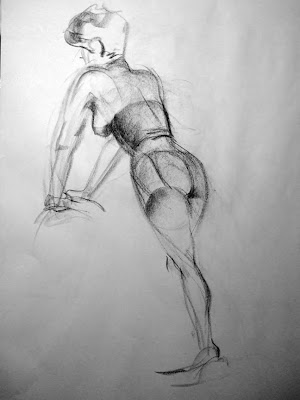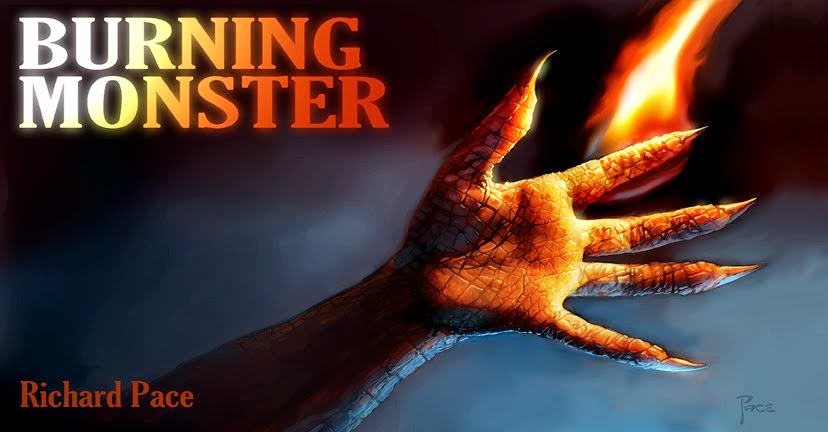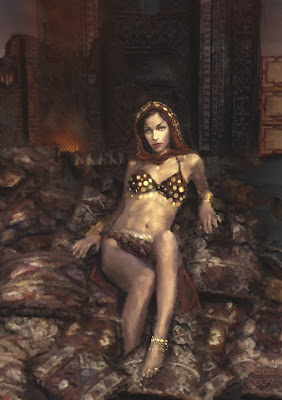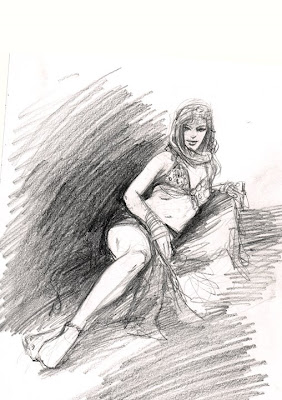
Sunday 1 November 2009
Annual Self-Portrait Day

Tuesday 6 October 2009
Dr. Sketchys -- October 5

As usual, we started off with gestures. . . .
I wanted to experiment with media a bit, so I started using pencil, gel pen, pentel white-out pen, ink and a makeup sponge for the five-minute poses. . . .

Obviously I was too slow to get very far for the first one. . .

I narrowed my focus a bit for the next few poses, but Honey liked to move her head quite a bit (especially when Brynne was taking photos), so drawing head shots was a little difficult.
Challenge!
Wednesday 2 September 2009
The Keyhole Sessions, Toronto
Three one-minute gestures -- kinda bad for me as I usually need about 10 to get a feel for the paper I'm working on and getting the proportions to flow right.

I missed the model's name, but she was stunning and a fabulous model.

She was joined for a few poses by an additional model, which was certainly fun to draw.

The models posed in front of a mirror -- I ignored it, but regret doing so now. Hopefully next time I'll incorporate some reflections.

The proportion issues stuck with me all night -- I cropped off the legs on this piece as they were embarrasingly small.
Tuesday 1 September 2009
Dr Sketchies: Tank Girl!
Photographer Brynne Kennedy, dropped her camera and most of her clothes, wore a helmet and hefted toy guns to portray the titular (tee-hee) grrrrl.
Gestures:

I'm sure every Dr. Sketchy regular has looked at Brynne's butt quite a bit -- usually while she's standing between you and the model, but this time we were supposed to stare at it.
Which was, you know, fine by me. . .
5-minutes -- or less as I goofed off some with Sharleena and the others at her table

Liked playing with the Pentel brush for the two little doodles at the bottom there.
There were the usual challenges. The first was to incorporate one of Tank Girl's kangaroo lovers. I didn't have any idea what to draw until the last minute. I won, but I think it was a victory of punch-line over drawing.

The second challenge was to give Tank Girl a Rob Liefeld-style gun. Brynne had actually written "Up yours" on her cheeks, in the actual pose she teased down her "shorts" to reveal that. I didn't really want her holding a giant Liefeld gun in her ass, so I changed it up a bit.
The last drawing was more inspired by the costume than her pose -- Brynne took a Flashdance-style pose stretched across a chair, but I really wanted her to take this sort of pose.

Brynne was such a great sport she actually took one extra pose like that after we were supposed to be done -- the drawing next to the ink sketches above was all I managed to do before time ran out. I was pacing myself for 10 minutes even though I knew it was a 5-minute pose.
As always, Sketchy's was a blast and a half. It was packed last night and I think Brett had to turn people away -- thus earning his nickname as "The Despot"! It's two of my fave models in two weeks, so I'm gonna show early.
~R
Wednesday 19 August 2009
Tuesday 18 August 2009
Hey, Conan!
Monday 17 August 2009
New Painting Project -- progress 1

Books You Should Have II
By Jack Hamm

This is a book I really wish I bought back when I started drawing seriously. There’s likely a great many reasons why I kept overlooking this old gem during my many, many trips browsing through the art section of every bookstore I wandered into in my teens. It might be the poorly designed brown and yellow cover or the overwhelmingly “old” feeling the book gives off or something else, but when I finally picked it up and flipped through it I felt like a moron for waiting so long.
This is probably the best all-round book for beginning imaginative figure drawing I’ve ever seen. I include Loomis’s great books; Fun With a Pencil and Figure Drawing. As valuable to the artist as all Loomis’s books are Jack Hamm covers all the basics for the young artist clearly, succinctly and affordably – I recently picked up a new copy cover-priced at 11.95 U.S.
Starting with a fine construction method for the head, Hamm emphasizes proportion throughout the book. Page 39 has a nifty illustration of the human proportions based on heads that always reminds me of something Grant Morrison could have done in his Doom patrol era.
One of the nicer aspects of this book is its section about clothing and folds. Too many aspiring comics artists just have no idea how to draw clothing on the moving figure and this would truly help them a great deal. The clothes are dated – no runners, sweats or other, more contemporary costume options are explored, but the basics are covered enough to allow the beginning artist to understand folds.
The best way to work with Hamm’s book is to copy his construction examples until you’re familiar with them, then find photos from life and extrapolate the construction on top of them. I’d suggest using tracing paper over magazine pictures or a fine permanent maker on the picture itself while having the book open to the relevant section you’re studying.
There are more thorough and more advanced imaginative drawing books out there, but I think this one is arguably the best to start with.
Sunday 2 August 2009
New Painting Project
Tuesday 21 July 2009
Dr Sketchy's Retro Art Show: Done!
Monday 20 July 2009
Dr Sketchy's Retro Art Show WIP2
Dr Sketchy's Retro Art Show WIP1
Several thumbnails later I come up with the pose that captures what I want -- Laura (I hope I'm remembering her name), was wearing and ankle bracelet and a toe ring or two and I want to emphasise it without having the feet point into a corner. Solution -- she's playing with one of the cushions with her feet. I think the "action" being more central and vertical will allow me to use other elements to maintain the composition.
Dr. Sketchy's Retro Art Show
Thursday 16 July 2009
DR. Sketchy's, July 13 2009
I brought the worst paper the draw on I've ever bought (BOO!)

No idea why I bought this paper. I rarely leave an art supply store empty handed and I'm prone to just buy things that I might try out, so I must have bought this pad on a whim. I grabbed it on a similar whim on the way out instead of my other stacks of paper. I really felt like using conté Monday, but after setting up at the Cameron House and making a few warm-up marks on the paper I had an immediate sinking feeling. The wise and gorgeous Sharlena was sitting next to me and commented that she didn't like this paper when she tried it some time ago. I tried a few other media on it and settled for carbon pencils. I really should have brought a nice slick newsprint or similar surfaced paper as that was what I really wanted to work with. Bad planning.
Since that was worst aspect of the night, I really shouldn't complain -- but since I already have I guess I'll have to live with it.

The second sketch challenge was EXTREME FAIRY TALES -- so I did a Bo Peep/Goldielocks mash-up. Sharleen won with a wonderful Peter Pan drawing and got a six-pack of delicious-looking cupcakes

Wednesday 8 July 2009
Carrie Catcher

Tuesday 7 July 2009
Books You Should Have
Whenever I review portfolios I almost inevitably recommend George Bridgman’s drawing books. They were first recommended to me by the first professional comics artist I met, George Freeman. The story he told me was that these were the books that Frank Frazetta used to learn anatomy. SOLD!
I went down to my local WH Smith’s bookseller and ordered the Dover edition of Bridgman’s Life Drawing. The book was a revelation on how to approach drawing the figure. I’d already seen a number of approaches using the stick figure and spheres and cylinders, but this was the first time I saw someone using nice, solid blocks. For the first time I was reading how the body was really put together and learning a system that made sense when put in context of a real body. As limited funds allowed I obtained all 5 of the currently available Dover paperbacks of Bridgman’s drawing books.
Now, most people might think I might be as big a booster for Bridgman’s Complete Guide to Drawing from Life, but they’d be wrong.
It’ll do if you really don’t have a choice, but, if you’re using the internet and can follow a link like this: Bridgman’s Life Drawing , you have a choice. I haven’t parsed the Complete book to see if the language has actually been altered, or how much of Bridgman’s organization has been disrupted, but I feel that the whole of Bridgman’s intent and approach is best taken in context of the book he placed it within.
Using Bridgman’s Books
I’d suggest starting with the one book Amazon Associates seems unwilling to let me list in the widget to the right, Bridgman’s Life Drawing. Luckily, I have what amounts to at least a yellow belt in web fu and I made a link from the title for those interested.
This book is really the best place to start with Bridgman. It was suggested to me the best way to study Bridgman was to copy each page from each book, cover to cover, and repeat until I understood it all. I’m going to pass along similar advice, but in an altered form:
1. Yes, do copy all of his drawings as you go through the books, (and do make a manikin from wire and blocks like he suggests), but don’t ever let it be mindless copying.
2. Think about why Bridgman drew shapes in a certain way, about why he merged masses together in a certain way.
3. Interrupt you sessions copying Bridgman to try and apply it to drawing from real life.
4. Try to understand why Bridgman is exaggerating and simplifying and try to apply similar thinking to exaggerating and simplifying your own drawing in your own way.
5. Do read his text, but understand that the real content in his books is gleaned from his drawings.
6. Only move on to the next book when you think you’ve taken what you can from the one you’re currently studying. Don’t fight to extract every bit of knowledge on the first pass – let the information come to you when you’re ready. The book and its contents will be there for you the next time you come to it.
I think the best order to approach studying the Bridgman books is this:
Bridgman’s Life Drawing
Constructive Anatomy
The Human Machine
Heads, Features and Faces
The Book of a Hundred Hands
The last two can be interchanged depending on your whim, since I feel the real core study is contained in the first three books, while the latter two are more about refining or breaking down the approach into more complex forms.
A real benefit to be taken from Bridgman is a solid foundation in understanding form and mass in space, which if you want to draw the human figure well from your imagination, you need. Bridgman isn’t about surface or rendering, it’s about developing a structure. In many ways, Bridgman’s approach is applicable to all imaginative drawing; start with accurate, simplified forms in space and develop them into more complex and detailed shapes as needed.
On a scale of 1-10, where 1 means the book shouldn’t even be looked at and 10 means it’s an artist’s bible I rate the Bridgman books
Bridgman’s Life Drawing 10/10
Constructive Anatomy 9/10
The Human Machine 9/10
Heads, Features and Faces 6/10
The Book of a Hundred Hands 6/10
Bridgman’s Complete Guide to Drawing from Life 7/10 (only if the others are unavailable)
***
I'm using Amazon.com as the default link online bookseller for it's near-ubiquitous place on the internet. I'm Canadian and most often use Chapters-Indigo for my online book buying. You should be able to find any book I review and recommend here at the bookseller of your choice, though I might earn gift certificates to buy even more art books if you buy them from the links to the right. What's of real importance is that the artists out there get the best information and support possible.
~R
Sunday 5 July 2009
What the Hell Have I Been Up To?
Things I want to pick up again now that things have settled some include returning to monthly ZUDA reviews, posting developmental artwork for things I can share with you, I want to review and suggest a number of art books from my library -- both how-tos and artist collections -- on a monthly-ish schedule.

The illustration above was for Damon Sasser's Two-Gun Raconteur, an excellent journal on the works of Robert E. Howard. More info and how to order below:
REH Two-Gun Raconteur #13 in now avilable.
This issue of The Definitive Howard Journal made its debut on June 12th at the 2009 Howard Days in Cross Plains to rave reviews.
Contents include: "The Black Moon" by Robert E. Howard, illustrated by Robert Sankner; "Kingdoms of Clouds and Moonmist" by Brian Leno, illustrated by Bob Covington; "The Hyperboreans Re-imagined" by Morgan Holmes, illustrated by Richard Pace; "Kings of the Night: A: Bran Mak Morn Portfolio" by Michael L. Peters; "The Skald and the King" by Chris Green, illustrated by Bill Cavalier; "The Long and Winding Road: A Poetic History" by Rob Roehm, illustrated by David Burton; "Sailor" Steve Cositgan: A Portfolio" by Clayton Hinkle; Verse by Frank Coffman; "The Mighty Revelator Passes" Tributes and Final Farewells to Steve Tompkins, plus additional artwork and features.
LIMITED EDITION of 250 numbered copies.
Price is $23.00 per copy ($19.50, plus $3.50 for US shipping and handling)
Order from and make checks and money orders payable to:
Damon C. Sasser6402 Gardenspring Brook LaneSpring, TX 77379
Payment also accepted via PayPal:orders@rehtwogunraconteur.com
I really enjoy contributing to projects like this, partly because I'm a Howardhead, but also because the journal is so well done.
Later all!
~Richard
Tuesday 31 March 2009
Tuesday 10 March 2009
Ain't Got Time Ta Bleed
It was obviously a more complex issue than I ever thought it was. Perhaps because I actually had a good deal of print education both in high school and college the bleed was readily understandable to me, but not so much to young people people without such. Let's hope I can be more clear with this!
Below you have a standard DC Comics 2-ply plate finish (that means smooth) sheet of bristol board:

I dropped the colors so the normally pale blue lines might show better at the smaller size. There's a good deal of technical info on that page when you look at it. A bunch of lines of different sorts making different sized rectangles -- and even some writing about them along one side:

It says: ARTIST AND LETTERERS: THE "LIVE ART AREA"IS WITHIN THE 8 7/8 X 13 15/16 DOTTED (- - -) LINE RECTANGLE. YOU MUST KEEP ALL LETTERING AND IMPORTANT ART WITHIN THIS AREA.
That's the rectangle I toned grey below:

It's so important I actually wrote my own note about restricting the important art and lettering in there. Now, important art might be an odd thing to read. All art on the board is important, of course, but this is specifically referring to the art that's important to the narrative and storytelling,
In this next example, the grey area is everything that should appear on the printed comics page. It's larger than the "LIVE ART AREA". In many ways it's like all the margins (white space) surrounding all the text in a novel. You can have headers and page numbers in the margin, but you won't find any of the actual story hanging out there. On a comics page you can have a good deal of art in the margins, but it's a design element to the page that can enhance the narrative, but cannot be crucial to it.

I'm being a little redundant here, but everything outside of the grey box in this second example will not be on the printed comic page. This area between the edge of the rectangle and the outermost blue line is called the "BLEED". It will either be trimmed out when they put the film into imposition prior to printing or it will be cropped off after the printed sheets are folded and bound into a comic book.
Here's a close-up:

It's from a photocopy, but I think you can see all the crop lines reasonably clear on the top, bottom and left side.
Here I indicated the 'LIVE ART AREA" with a blue-grey overlay. The bleed and everything else is in that sexy magenta-ish color. As you can see I kept my panels pretty much within the 'LIVE ART AREA" with the exception of a little cheating in the last panel to show more trees. While keeping the woman and most of the tree she's sitting on within the live art area (tired of writing that in all caps) I draw the tree and branches out into the margins behind the other panels. Everything I do this with gets drawn out to the outermost blue line.

I'm not going to argue that this is a particularly good page, but it is a decent example of using the live art area and the bleed.

Thursday 5 March 2009
Unknown Armies
After I left comics during the late 90s crash, I started doing a good deal of illustration in addition to some storyboarding and other game art. One of the games I did quite a bit of work for in a short period of time was this roleplaying game called Unknown Armies. I took every new assignment as an excuse to play with some different media or style.

I took the assignment to draw a number of the interior illustrations (I also did the cover -- I should dig up a scan of that). The illustrations were going to be printed inn black and white, and I had very little time to do them (from other work, not any deadline pressure). Instead of the tonal pencil drawings I had done the first time I worked for these fine folks, I opted to do looser pencil sketches and work with quick and loose watercolour to get the values in. I pulled out highlights with gesso and drew back inn with pencil as needed.

Weirdo that I am, I chose to use a burnt umber-y colour instead of lamp black, which would be the practical colour to choose. So the pieces look like this:

I received some nice attention for the cover and some interesting notoriety for another interior illustration; I drew the monster created by the karmic/spiritual/ectoplasmic residue left by a rape. I was told a number of stored refused to carry the book because of the illustration.
I'll keep looking for the illustration -- failing that, it (and the ones above) are in the book Postmodern Magick.





















